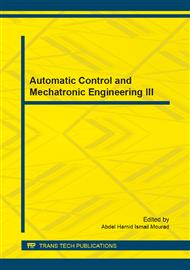p.149
p.153
p.158
p.165
p.169
p.173
p.181
p.189
p.194
Application of Support Vector Machine in Identifying inside Moldy Chestnut Using Near Infrared Spectroscopy
Abstract:
NIR spectroscopy has been applied in detecting inside quality of chestnut successfully. In this work, Support Vector Machine Discriminant Analysis was utilized to identify the qualified chestnuts, the serious moldy chestnuts and the slight moldy chestnuts using their Near infrared spectra region from 833 nm to 2500 nm. 109 chestnut samples were involved and four different preprocessing methods were compared. The results showed that for all the models, the average correct rates of training set and validation set were higher than 90%. The performance of model based on raw spectra was not as good as other models, which indicated the necessity of preprocessing. The models based on the spectra preprocessed by first derivative and multiplicative scatter correction had the same performances, with 97% and 85% as the correct rate of training set and validation set. The models based on the spectra preprocessed by Standard normal transformation has 100% correct rate of training set while 88% of validation set. The second derivative model had the best result with 100% and 90% as the correct rate of training set and validation set. These results demonstrated that the NIR spectroscopy had capability to detect interior mildew of intact chestnut nondestructively.
Info:
Periodical:
Pages:
169-172
Citation:
Online since:
August 2014
Authors:
Keywords:
Price:
Сopyright:
© 2014 Trans Tech Publications Ltd. All Rights Reserved
Share:
Citation:


